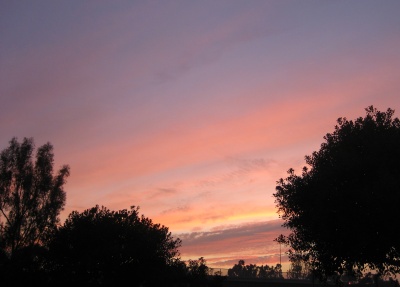
Just after sunset on Wednesday, February 7.
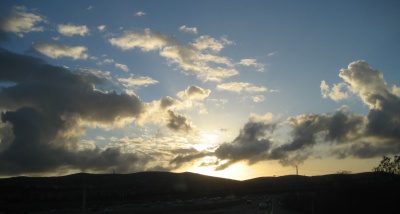
Just before sunset on Monday, February 12.

Just after sunset on Wednesday, February 7.

Just before sunset on Monday, February 12.
The skies were surprisingly clear today. Four of us at work walked outside after sunset to a bridge near the office, and saw Comet McNaught. It was visible from ~5:10/5:15 to 5:28, at which point it slipped below the line of hills to the west.
We saw it against the red sky, slowly dropping through the (fortunately sparse) clouds. It was easily visible to the naked eye as a fuzzy white spot, with a hint of a tail pointing straight up that was a lot clearer in binoculars. The tail looked like a U or a V, fanning out at what looked like (but probably wasn’t) a 45° angle.
Well, my fingers are finally warming up. (I made the mistake of not grabbing my jacket, and went out just in my sweater.) Time to wrap stuff up.
Update January 13: I managed to catch another glimpse of it tonight. Unfortunately I was just arriving at the shop to pick up my car, and it was just closing, so I didn’t have a chance to watch it set (or see much more than a fuzzy white dot.) My watch said 5:02. By the time I got out, it had set beneath the building across the street, and there just wasn’t anywhere nearby enough with a clearer view of the western horizon.
On the plus side, I did manage to spot Venus while the sky was still light, and get a picture. It’s not quite as exciting as spotting it at one in the afternoon, but by adding more blue, you get an idea of what that looked like:
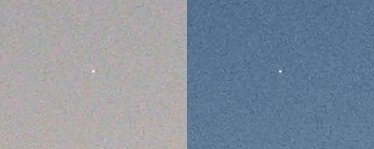
Update January 14:
I was looking over the photos I took last night (Saturday) and discovered I could actually find it by messing around with levels. On the left is the original photo, with a little bit of color correction to match what the sky looked like. The background’s still too bright to see the comet, though it was visible to the eye. On the right, I’ve adjusted the heck out of the image, and there’s a very slight bright spot right where it should be (I framed the shot so that the comet would be near the light pole, making it easier to find). Actually, now that I look at it again, it’s just barely visible in the less-processed photo on the left.
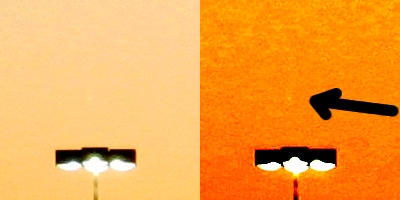
Also, this is cool: the comet has gotten bright enough to be spotted in daylight. (via Slashdot) I didn’t have any luck looking for it this afternoon, but I chalk that up to lower altitude and city haze.
Update January 15: I spotted something today, but I’m not sure what…
Here are a couple of photos, one just before sunset, the other just after, over the past month.
First up is a twilight view of South Coast Plaza. On Friday the 13th, we went to the nearest Borders to pick up The End of Lemony Snicket’s Series of Unfortunate Events and Neil Gaiman’s new short story collection, Fragile Things. We ended up crossing the bridge over to the main section of the mall, turned around, and saw an amazing twilight display with clouds silhouetted against the blue.
We stopped to take pictures. We weren’t the only ones.
Perhaps an hour later, the rainstorm arrived.
Next up is from this past Monday, October 23. I was driving up the 405 after work and noticed that there were some feathery clouds in the right area, so I started looking for sundogs. Normally I don’t find anything. It’s Southern California, after all, so the right conditions are relatively rare. (Though occasionally I see something spectacular like the full halo I caught in February.)
To my surprise, I saw a faint bright spot in the clouds, level with and to the right of the sun. It got brighter over the course of my drive, with hints of red, orange and yellow creeping in on the sunward side: a classic sundog. Once I got onto city streets, I had a chance to stop and take a picture.
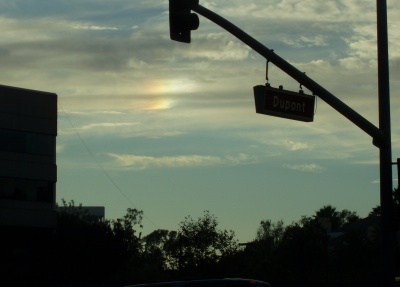
Monday morning dawned foggy. By the time we left for work, most of the fog had burned off, but we looked out the car window and saw a huge, billowing gray cloud hugging close to the ground. If this had been the usual fire season, or if there had been no fog to start with (or if there had been time for coffee to take effect), I think we would’ve both immediately recognized it as smoke from a brush fire. The Sierra fire in the Cleveland National Forest had started just a few hours earlier.
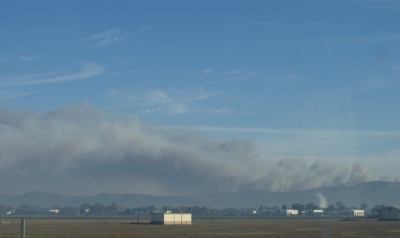
There was still fog around, though. Continue reading
The first photo is from Wednesday morning around 8:00. Katie took it on our drive to work. There’s actually another shot that shows more of the sky, but this one is more striking. The second shows tonight’s sunset as seen from the Metro Pointe parking lot. Yes, it’s a freeway in the foreground, but the sunset itself was incredible. Both thumbnails are linked to larger copies of the photos.
Finally, here are some vaguely lenticularish clouds I saw looking north at sunset on Friday. This one’s full-size already:

I saw the planet Venus four times on my walk to and from lunch today! Yes, in broad daylight!
Someone on Slashdot mentioned it was possible last week. I took it seriously because back in high school, I used to watch Venus fade into the brightening sky on winter mornings. Often I could still find it once I arrived at school, since I knew exactly where to look.
I tried unsuccessfully a couple of times over the past week, but today I had a ~20-minute walk mostly facing southward, so I thought I’d give it a shot.
I used the Moon as a guide, trying to guess the distance based on how far apart they were last night. As I passed through a building’s shadow, I spotted a stationary white dot in the right area, a bit more than a hand span away from the crescent Moon in the direction of the sun, barely visible next to some wispy clouds. I couldn’t find any sign of a con trail, and it didn’t move, so it clearly wasn’t an airplane, but I was able to look away and back and still see it. Continue reading
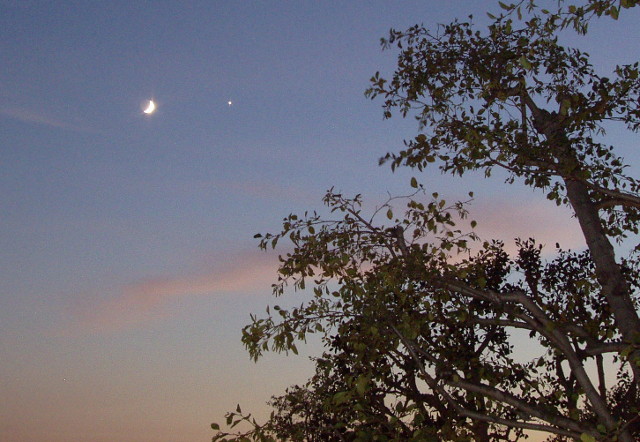
This view of the Moon and Venus was taken from our apartment balcony earlier this evening.
I also took a picture yesterday, from the top of a parking structure near John Wayne Airport (we went to a show at UCI later that evening.) You can see the red trail an airplane left as it crossed the frame:
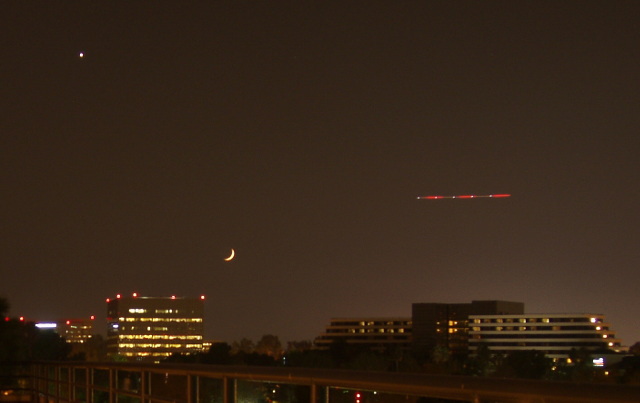
Having seen that pairing last night, I knew I had to be ready to catch it today! I figured the Moon would be a lot closer, but I hadn’t expected it to actually pass Venus tonight. It really gives you an idea of how far the Moon moves in 24 hours. (or, in this case, roughly 23 hours, since yesterday’s picture was taken at 6:00 and today’s was taken at 5:10).
To be honest, I wasn’t actually certain it was Venus. It was my first thought, because of the brightness and the color, but I kept thinking it was too far from the sun. I kept trying to convince myself it was Jupiter or maybe Saturn (it wasn’t red enough for Mars, and besides, I’d seen Mars on the other side of the sky the night before). When I looked it up and realized it was Venus, I started remembering my days in high school when I would walk to school for a 7:00am “zero period” class. In winter it would sometimes be just dark enough when I left to see the planets and the brightest stars. I would keep my eye on Venus as the sky brightened, trying to see how late I could still see it by knowing exactly where to look.